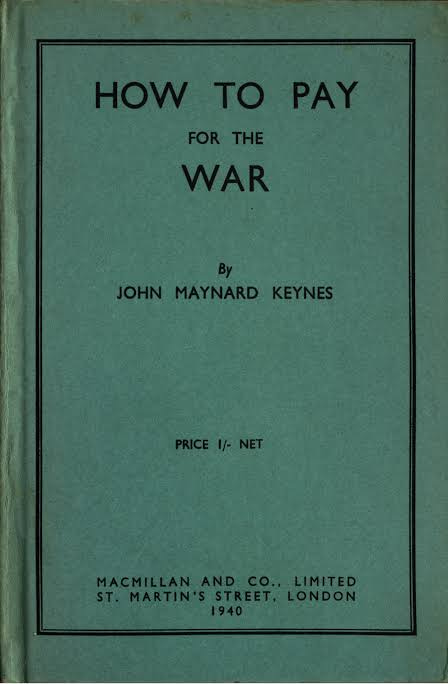Keynes and Inflation
Revisiting Keynes' How to Pay for the War
Keynes’ How to Pay for the War remains worth reading, being both incredibly short (under 80 pages) and accessibly written. Where The General Theory focuses on persistent unemployment due to insufficient aggregate demand, How to Pay for the War faces the opposite issue, how to control inflation under conditions of excessive aggregate demand and the supply constraints of a war economy.
The problem Keynes described was simple, how to keep aggregate demand low during the war while distributing the burden equitably.
The Framework
Keynes treats inflation as fundamentally a collective action problem. With supply fixed, increased money earnings cannot increase consumption at a societal level. However, each individual can increase their relative share by spending more, and is therefore incentivised to do so. He compares the problem to one of traffic, each individual’s spending devaluing those of their colleagues:
An individual cannot by saving more protect himself from the consequences of inflation if others do not follow his example; just as he cannot protect himself from accidents by obeying the rule of the road if others disregard it. We have here the perfect opportunity for social action, where everyone can be protected by making a certain rule of behaviour universal.
The Solution
Keynes’ plan consisted of 4 parts:
Establish a system of deferred pay across all income groups. This was seen as having two key advantages. Firstly, it would allow a more equitable distribution of immediate income, and secondly, that shares in the national debt could be dispersed throughout the population rather than be concentrated in the hands of the rich, as it does usually. To the extent new taxes were introduced rather than deferred pay, Keynes preferred they be levied on higher income groups.
Establish a capital levy, similar to a temporary wealth tax, to reduce the national debt following the war. Keynes preferred that this levy take place in instalments, rather than as a one-off payment, to facilitate the tax’s collection and reducing its disturbance. He also noted that this may facilitate an eventual permanent capital tax which would be a valuable addition to our fiscal machinery and has certain important advantages over income tax.
While Keynes supported this measure, he was clear the tax could not resolve the aggregate demand problem during the war, simply redistributing the assets of the rich to the state, noting:
The main point is that a Capital Levy now would do little or nothing to solve the immediate problem. A Capital Levy on a scale worth having could not be met out of the current consumption of the wealthy. They could only pay it by handing over assets to the Government, the capital value of which would be of no assistance whatever to the immediate financial task.Establish an effective floor to prevent poverty during the war, including through exempt minimum, a sharply progressive scale and a system of family allowances. Keynes writes eloquently on the need for such a minimum even during this moment of crisis.
At first sight it is paradoxical to propose in time of war an expensive social reform which we have not thought ourselves able to afford in time of peace. But in truth the need for this reform is so much greater in such times that it may provide the most appropriate occasion for it.Finally, provided the above conditions are met, Keynes suggests to link money incomes to changes in limited rationed articles, and to endeavour to prevent these essential articles rising in prices.
The No Plan Result
Keynes was very clear that without any plan, the ensuing inflation would lead to far less equitable results. As goods are fixed in the scenario, he predicted the price of consumer goods will rise and this inflation will swell the relative share of the owners of the means of production.
aggregate incomes will indeed rise… (apart from the effect of any rise in the price of goods bought by the Government), but not everyone’s income will rise in the same proportion, if at all. The initial increase of income will mainly belong to a limited class of individuals and of trading and manufacturing companies, whom (without intending any insult, for it is by no fault or intention of theirs) we can call for short “the profiteers.
He predicted a substantial portion of these funds wouldn’t be further circulated as it with either be: saved, retained as profits within the companies, or taxed by the government.
In response to the inflation, workers may be expected to push for higher wages, Keynes predicting some wage-price spiral effects, but that eventually the burden would be distributed to groups with relatively fixed incomes.
Keynes’ Legacy
While many elements of the work are clearly dated, Keynes reminds us of the inherently political natural of how aggregate demand is managed within a democratic society. In situations where aggregate demand must be reduced, the question remains how.



The good parts are timeless advice. Tax consumption progressively to re-direct resources to high- value public expenditure, staving off defeat in a war only being an extreme case of high-value public expenditure. Rather than actual forced saving (Keynes's differed payments) I'd encourage saving by giving tax credits to the long-term saving of low-income people. [A progressive consumption tax already gives high-income people a strong incentive to save.]